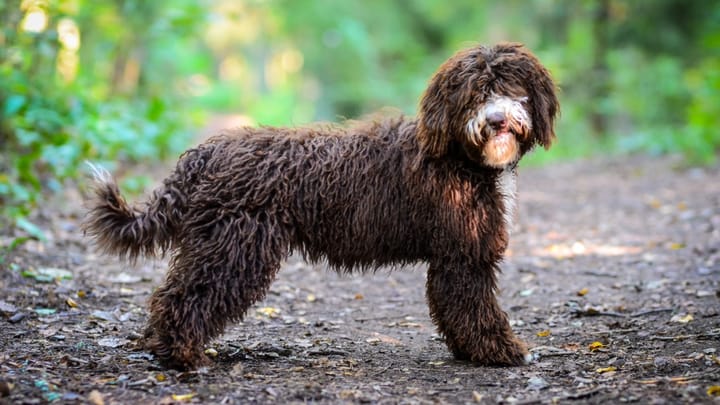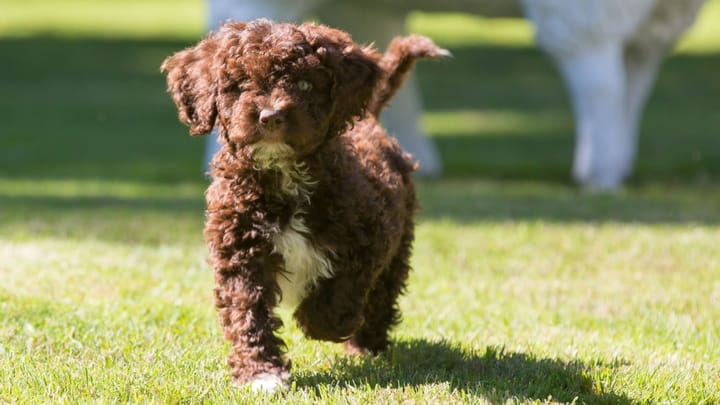Spanish Water Dog
Other name: Perro de agua espanol


The Spanish Water Dog is used as a hunting, fishing or sheepdog. Docile, happy, hard-working and very well-rounded, they have a strong aptitude for learning thanks to their great capacity for understanding. This dog can adapt to all situations and conditions. They make excellent utility dogs that can also be considered as pleasant pet dogs.
|
Life expectancy |
The Spanish Water Dog has a life expectancy of between 10 and 14 years |
|
Temperament |
|
|
Size |
Medium
|
|
Adult size |
Female
Between 16 and 18 in
Male
Between 17 and 20 in
|
|
Adult weight |
Female
Between 31 and 40 lb
Male
Between 62 and 49 lb
|
|
Coat colour
Dogs can be single-coloured (solid black, brown, white), white with various shades or two-tone (white and black or white and brown), but never tricoloured. |
Black White Brown |
|
Type of coat
The coat length can be from 1 inch to 6 inches when you stretch out the curls. The hair is a curly, fuzzy texture. When the hair is long, cords are subsequently formed. |
Long |
|
Eye colour
The iris is hazel and must match the colour of the coat. |
Brown
|
|
Purchase price |
The Spanish Water Dog costs between £810 and £830 |
In their country of origin, they are used as search dogs along firefighters (searching for lost persons) and the police (searching for drugs and other illegitimate items at airports)
In the United States, they are used for the search of bodies and in Holland, they are used especially for the search of dead bodies in marshy grounds.
Finally, in Spain, an educational project managed by the Ministry of National Education and led by the president of the Spanish breed club has made these water dogs a therapist dog for the elderly and disabled children.
More details about the Spanish Water Dog
Spanish Water Dog: Origins and history
The existence of this dog in the Iberian Peninsula dates back to a very long time ago. It’s even said that the Spanish Water Dog could be the oldest out of their category. The largest number of them is found in Andalusia, where they have been known for centuries as a “Turkish dog” and are used as sheepdogs. Their genetic characteristics haven’t really changed through selection until today thanks to their numerous and versatile working qualities.
Physical characteristics of the Spanish Water Dog
A rustic, well-proportioned, average-weight, dolichocephalic, rather elongated dog with a balanced form and appealing profile, the Spanish Water Dog has an athletic nature and a well-developed muscle structure. Slightly slanted, their eyes are very expressive. Their ears set moderately high on their head, are triangular and hang down. The tail sits at an average height.
FCI classification of the Spanish Water Dog
-
Group 8 - Retrievers - Flushing Dogs - Water Dogs
-
Section 3 : Water Dogs
Spanish Water Dog: Characteristics
Spanish Water Dog: Behaviour
Training a Spanish Water Dog
Particularly docile, this dog’s learning abilities are almost endless. It’s often said that the Spanish Water Dog alone possesses the qualities of three or four other dogs, so their capabilities are very diverse.
Very easy to train, this dog understands what is expected of them extraordinarily quickly, as long as teaching methods are respectful and kind toward them.
With this breed, the basic principles quickly sink in but beware, regular and consistent hard work is necessary in order to have a Spanish Water Dog as perfect as they seem on paper.
Spanish Water Dog: Lifestyle
Breed compatibility Spanish Water Dog
Spanish Water Dog: Purchase price
The price of a Spanish Water dog varies according to their age, origin and sex. The average cost of a pedigree is around £830.
Regarding the average budget required to meet the needs of a dog of this size, it costs around £35 a month.
Spanish Water Dog: Shedding
Average
Hair loss is moderate throughout the year and increases twice a year around moulting time.
Spanish Water Dog: Grooming
Despite appearances, this curly-haired (even corded) dog is not difficult to maintain as no brushing is really necessary. Some dogs can be clipped (it’s recommended to do this twice a year) but the official standard stipulates that this should not represent an “aesthetically pleasing” cut.
Their drooping ears should be cleaned regularly, especially after each swim to avoid an ear infection that is commonly found in water dogs.
Spanish Water Dog: Health
The life expectancy of this dog is estimated at around 12 years.
The Spanish Water Dog is very resilient and renowned for their great resistance to disease.
Rather accustomed to the mild temperatures of their country of origin, the Spanish Water Dog does not suffer from the heat but it’s still better to spare them from intense heat for example, during heat waves.
Their hair allows for very effective resistance, especially to variations in humidity. Therefore, they’re protected from bad weather and they can even live outdoors.
Full of energy and vitality, it’s very rare to see an overweight Spanish Water Dog. If this is the case, then the dog’s physical routine must be seriously reconsidered.
This breed is lucky enough to have a very good health and not be subject to hereditary diseases. However, owners must pay attention to their ears, which are specifically prone to ear infections.






